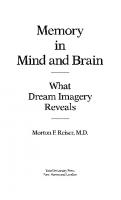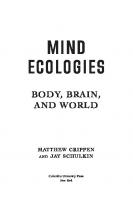Two Views of Mind: Abhidharma and Brain Science 1559390816, 9781559390811
Two Views of Mind: Abhidharma and Brain Science offers a clear overview of perception, thought, and awareness in Tibetan
254 104 8MB
English Pages 220 [252] Year 1997
Recommend Papers

- Author / Uploaded
- Christopher deCharms
File loading please wait...
Citation preview
Abhidharma and Brain Science
Christopher deCharms
^oanat/^
Lavery Library St.John Fisher College Rochester, New York
Two Views of Mind Abhidharma and Brain Science
■ > ^
. i
C
..
>' ■:
■■ % ■
\
1
X
i
Two Views of Mind Abhidharma and Brain Science
R. Christopher deCharms
with translation by
Gareth Sparham, Sherab Gyatso, and Tsepak Rigzin
Snow Lion Publications Ithaca, New York
Snow Lion Publications RO. Box 6483 Ithaca, New York 14851 USA 607-273-8519
Copyright © 1998 R. Christopher deCharms First edition USA 1997 All rights reserved. No portion of this work may be reproduced by any means without prior written permission from the pubhsher. ISBN 1-55939-081-6 Library of Congress Cataloging-in-Publication Data deCharms, R. Christopher, 1966Two views of mind: Abhidharma and brain science / R. Christopher deCharms: with translation by Gareth Sparham, Sherab Gyatso, and Tsepak Rigzin. — 1st ed. p, cm. ISBN 1-55939-081-6 1. Abhidharma. 2. Buddhism-Psychology. 3. Perception. 4. Neuroscience. I. Sparham, Gareth. 11. Sherab, Gyatso BQ4200.D43 1997 128' .2' 0882943-dc21
97-41162 CIP
PRINTED IN CANADA
Table of Contents
SECTION I: THE PURPOSE OF THIS BOOK Introduction Tibetan Philosophy and Neuroscience? How This Material Is Presented Sources of This Material 1 The Usefulness of an Exchange: A Discussion with His Holiness the Dalai Lama Usefulness of an Exchange for Practitioners and for Academic Study A Scientific Perspective on Ancient Debates of Tibetan Buddhism
15 15 16 17 19 19 22
SECTION II: A GLIMPSE OF THE TIBETAN VIEW OF MIND 2 Approaching the Tibetan View of Mind A Little Philosophical Game, from Two Cultural Perspectives Meeting the Tibetan Lamas 3 A Very Different Metaphor of Mind—His Holiness the Dalai Lama The Tibetan Approach to Mind—A Painting with No Wall 4 A Discussion with the Venerable Lobsang Gyatso: Mind and Mental Factors
25 26 26 29 29 31
The Presentation of Mind and Mental Factors in Tibetan Buddhism Consciousness as Clear and Knowing Consciousness as Authoritative Regarding Appearance Intensity of Clarity Awareness Is Non-Physical Awareness and Physical Being Awareness Can Increase and Decrease without Limit
31 36 36 37 38 39 40
SECTION III: BUDDHISM AND SCIENCE 5 Is Buddhism Scientific? No A Difference in Authority: Meditative Observation vs. Empirical Verification A Different Dualism: The Mind-Body Problem and the Subject-Object Problem Difference in Method: Description vs. Mechanistic Analysis The Buddhist Perspective on the Mind—Descriptions of Consciousness The Neuroscience Perspective on the Brain—Mechanisms of Behavior Different Views of Causation The Importance of the Differences Between the Two Systems 6 A Discussion with Kamtrul Rinpoche—A Different Authoritative Base The Power of Two Types of Authority: Observation and Reason
45 46 48 50 50 52 53 55 57 58
SECTION IV: PERCEIVING THE REAL 7 Perception in Tibetan Abhidharma and Western Neuroscience The Sautrantika View of Direct Perceivers Definition of a Direct Perceiver The Mode of Functioning of Direct Perception in Tibetan Buddhism Divisions and Types of Direct Perceivers The Two Truths in Brief Conceptual Truths—The Objects of Thought Nonconceptual Truths—The Objects of Direct Perception Direct Perceivers Know Their Objects Completely and with Bare Awareness
63 63 63 65 65 67 67 68 69
Mechanisms of Direct Perception The Conditions of Direct Perception Aspected Direct Perception The Units of Direct Perception The Understanding of Perception from Contemporary Neuroscience Definition of Perception The Functions of Perception The Measurement of Perception Mechanisms of Perception—Vision The Visual Processing Hierarchy of the Brain Awareness Takes Place over Time and Space Perceptual Illusions Comparing the Two Systems of Thought The Question of Aspected Perception Where Is the Aspect of Aspected Awareness? Is the Medium of the Aspect Static and Passive, As in a Mirror Reflection? How Many Aspects Appear to Consciousness at Once? What is a Particular, a Unit of Perception? Does One Partless Particle of Perception Equal One Photon? Is There a "Partless Particle" of Perception at All? Recognizing Aggregated Objects What Can Neuroscience Learn from the Buddhist Presentation of Perception? 8
A Discussion with His Holiness the Dalai Lama: Aspects of Perception How the Aspect of an Object Is Cast to the Perceiving Mind Separating the Individual Functions of the Perceiving Mind
9 A Discussion with Lati Rinpoche: Perception and the Illuminating Nature of Mind Direct Perception: Its Causes and the Role of the Previous Moment of Mind Consciousness Is Not the Brain The Illuminating Element of Mind The Causal Sequence of the Mind Stream The Flow of Bodily Energy and the Illuminating Essence
70 70 71 72 75 75
76 77
78 79 82 82 84 84 84 86
87 88
89 90 91 92 94 95 97 101 103 104 105 106 108
SECTION V: IDEAS OF REALITY 10 Concepts in Tibetan Abhidharma and Western Neuroscience The Use of Concepts in Tibetan Buddhism What Conceptual Thoughts Are—the Sautrantika Perspective Definition of a Conceptual Consciousness What Conceptual Thoughts Are For The Purpose of Conceptual Thought Is to Understand What Is Not at First Perceived How Conceptual Thought Grasps Reality Two Types of Thought and Their Objects "Conventional" and "Ultimate" Minds The Objects of Conceptual and Directly Perceiving Minds Objects of a Direct Perceiver Objects of a Conceptual Mind The Mistakes of a Mistaken Mind and the Truth of Conceptuality Mistakes of What Appears to the Mind Mistakes of What the Mind Ascertains The Negative Mode of Action of the Mind in Thought Negative and Positive Phenomena Non-Affirming Negatives Affirming Negatives Mental and Objective Affirming Negatives Double Negative Exclusion Objects The Mode of Action of Conceptual Thought in Terms of Its Object The Objects of a Conceptual Mind: Meaning Generalities and Double Negative Exclusions The Reason for the Presentation of Exclusions Rather than Positive Phenomena Presentation of How a Conceptual Consciousness Is Induced Conceptuality in the Presence of an Object Being Observed Conceptuality Induced by Memory Conceptuality Induced by Reason Concepts in Contemporary Neuroscience Conceptuality as a Neural Engine—Metaphors from Physical Science
113 113 114 114 117 117 118 119 119 120 121 122 123 124 124 126 127 128 129 129 131 131 132 134 135 135 137 139 140 141
The Parallel Processing Hierarchy in Brief Where Is the Mental Semblance? The Standard Theory—Generating Concepts from Positive Features A Source of the GeneraUty of Thought Contrast with the Samkhya View Concepts as Descending Exclusions Ascending Perceptual Information Descending, Negative Conceptual Information Inseparable Mixing of the Object of Engagement and the Meaning Generahty
Comparing the Two Systems and Considering Unanswered Questions Some Debated Points within the Gelugpa Presentation of Sautrantika Term and Meaning GeneraHties—Separate or United? Separate Components of Concepts A United "Meaning of the Term" Separate Representations of Terms and Meanings in the Brain The Mode of Arising of Mental Direct Perceivers Alternating Production Production of Three Types Production at the End of a Continuum Concurrent Perceptual and Conceptual Thought Spanning the Two Truths—General and Specific Objects
11 A Discussion with Gen Damcho—Objects of Thought The Meaning Generality or Mental Semblance of an Object of Thought Realization of an Object Through Conceptuality or Direct Perception The Four Types of Objects of a Mind Objects of a Conceptual Mind Objects of a Directly Perceiving Mind The Reason for Positing Exclusion Objects (Isolates) Conceptual Awareness of a Mental Object A Refutation of the Ultimacy of Perception by Neuroscience and Prasangika Madhyamika
144 145 147 147 148 149 149 150 150
151 151 151 152 153 153 155 155 156 156 156 158
161 161 162 163 164 167 170 175 176
12 A Discussion with Lati Rinpoche—Ideas, Concepts, and Terms Can a Concept Exist in the Absence of a Term? Conceptualizing Objects through Exclusion How Conceptualization Arrives at Its Exclusion Object Objects of Thought—Double Negatives A View from Neuroscience A View from Tibetan Buddhism Forming a Concept by Introduction and Verbal Designation The Necessity of a Term for a Concept Are Concepts Positive or Double Negative? A Stable Memory is Dependent on the Use of a Term
178 178 181 184 187 187 189 190 191 193 194
SECTION VI: MEMORIES OF EXPERIENCE 13 A Discussion with Kamtrul Rinpoche: Memory and the Freedom of the Mind A Western View of Awareness and Memory Based on Neural Activity Memory and Taming the Wild Horse Mind 14 A Discussion with Lati Rinpoche: Memory and the Subtle Channels of the Mind An Introduction to Channels and Pathways within the Nervous System The Flow of Mind Like Water in a River The Importance of Having a Term for Having a Concept 15 A Discussion with Gen Damcho: Objects of the Mind and Memory Perceiving Objects at the "Mind Door" Retrieving Concepts from Memory Memories As Potentials for Future Thoughts
199 199 202 206 206 207 211 213 213 215 216
SECTION VII: CONCLUSIONS: WHAT CAN BE LEARNED? 16 The Mind from Inside and Out New Ideas for Western Science Forming a Link Between Subjective Experience and Empirical Science Philosophical Underpinnings and a Definition of Consciousness The Issue of the Subject
223 223 223 2^4 224
New Ideas for Buddhism Subtle Channels and Physical Anatomy Mechanistic Analysis Brain Plasticity and the Buddhist Idea of Tr^sformation Tibetan Buddhism and Western Science— Complementary Views Knowledge of Mind and Its Limits Sense of Self ACKNOWLEDGMENTS NOTES
225 226 226 227 228 228 229 231 233
^
‘-i
WJ- ,
-.
1
■»
Sa
«;
.
* ' f \i.^ -V '■ 4l
""V'’
>■ .ili wAi
•’•:.
V-
"f- 5^ *>«!
,•■ 4 7'o>.;
S'*1 ‘J
.^ho'V • ■•'‘'%.i-T
^
*
■
i-fr']t»:'i") .*.’.*
fc- ns,-*'* » T34
V
SECTION I THE PURPOSE OF THIS BOOK
For many minds, something in the body changes, and from this, mind comes. There is also, you see, another kind of mind which controls the body. So how to prove this? 1 think that there is still a lot of work to be done. More discussion, more experiments. —H. H. the Dalai Lama One thing I would say might be common between us—no matter that the approach may be different, science or Buddhism—is that when we study, contemplate, and even meditate, we see our investigating nature. Even in meditation we are investigating. We analyze and try to understand things in their proper perspective. 1 believe that scien¬ tists are also analyzing things, examining things, observing things; they are doing research. That is what 1 value very much. So, in fact, they come to a common ground. 1 feel that in this way we comple¬ ment each other. So our sacred books, spoken by an enlightened be¬ ing, meet with your ideas.... —Lati Rinpoche
.•t
a. ,
r J.
riK
f ■
.
-■
*
A%”*^ 1* .
. # .J^'" >''’J-'.3i'
.■4' ••'uJs./‘ 'i*^.
•









